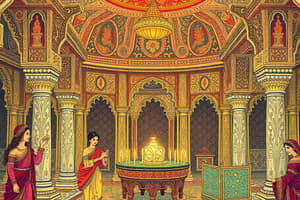Podcast
Questions and Answers
What is the approximate time period during which the Gupta dynasty existed?
What is the approximate time period during which the Gupta dynasty existed?
- 320-550 CE (correct)
- 500-700 CE
- 400-600 CE
- 200-300 CE
Who is credited with establishing the Gupta Empire and expanding its territories?
Who is credited with establishing the Gupta Empire and expanding its territories?
- Chandragupta II
- Samudragupta
- Sri Gupta
- Chandragupta I (correct)
What is the Gupta dynasty often referred to as due to its significant cultural, scientific, and artistic achievements?
What is the Gupta dynasty often referred to as due to its significant cultural, scientific, and artistic achievements?
- The Golden Age of Ancient India (correct)
- The Iron Age of Ancient India
- The Silver Age of Ancient India
- The Bronze Age of Ancient India
What significant mathematical concept was developed during the Gupta period?
What significant mathematical concept was developed during the Gupta period?
What is the name of the language that was developed during the Gupta period?
What is the name of the language that was developed during the Gupta period?
What is the name of the caves that were created during the Gupta period?
What is the name of the caves that were created during the Gupta period?
What was the result of the Gupta dynasty's strong economy and trade network?
What was the result of the Gupta dynasty's strong economy and trade network?
What led to the decline of the Gupta dynasty in the 6th century CE?
What led to the decline of the Gupta dynasty in the 6th century CE?
What is the legacy of the Gupta dynasty?
What is the legacy of the Gupta dynasty?
Who is Chandragupta II also known as?
Who is Chandragupta II also known as?
Flashcards are hidden until you start studying
Study Notes
Overview
- The Gupta dynasty was an ancient Indian empire that existed from approximately 320 to 550 CE.
- It is considered one of the most powerful and influential empires in Indian history.
Founders and Rulers
- The founder of the Gupta dynasty was Sri Gupta (c. 320 CE).
- Other notable rulers include:
- Chandragupta I (c. 335 CE): Established the Gupta Empire and expanded its territories.
- Samudragupta (c. 335-375 CE): Conquered many territories and expanded the empire.
- Chandragupta II (c. 375-415 CE): Known as Vikramaditya, he was a patron of the arts and sciences.
Achievements and Contributions
- Golden Age of Ancient India: The Gupta dynasty is often referred to as the Golden Age of Ancient India due to its significant cultural, scientific, and artistic achievements.
- Mathematics and Astronomy: The Gupta period saw significant advancements in mathematics and astronomy, including the development of the decimal system and the concept of zero.
- Literature and Arts: The Gupta period was marked by a flourishing of literature, art, and architecture, including the development of the Sanskrit language and the creation of the Ajanta and Ellora caves.
- Trade and Economy: The Gupta dynasty established a strong economy and trade network, with trade connections to the Roman Empire and other regions.
Decline and Legacy
- The Gupta dynasty declined in the 6th century CE due to internal conflicts, external invasions, and the rise of regional kingdoms.
- The Gupta dynasty's legacy includes its significant cultural, scientific, and artistic achievements, which continue to influence Indian and global culture to this day.
Gupta Dynasty Overview
- Ancient Indian empire that existed from approximately 320 to 550 CE.
- Considered one of the most powerful and influential empires in Indian history.
Founders and Rulers
- Sri Gupta (c. 320 CE) founded the Gupta dynasty.
- Notable rulers include:
- Chandragupta I (c. 335 CE) who established the empire and expanded its territories.
- Samudragupta (c. 335-375 CE) who conquered many territories and expanded the empire.
- Chandragupta II (c. 375-415 CE) also known as Vikramaditya, who was a patron of the arts and sciences.
Achievements and Contributions
- Marked the Golden Age of Ancient India due to significant cultural, scientific, and artistic achievements.
- Mathematics and Astronomy advancements:
- Developed the decimal system.
- Introduced the concept of zero.
- Literature and Arts:
- Saw the flourishing of literature, art, and architecture.
- Developed the Sanskrit language.
- Created the Ajanta and Ellora caves.
- Trade and Economy:
- Established a strong economy and trade network.
- Had trade connections to the Roman Empire and other regions.
Decline and Legacy
- Declined in the 6th century CE due to internal conflicts, external invasions, and the rise of regional kingdoms.
- Left a lasting legacy in Indian and global culture, with significant cultural, scientific, and artistic achievements that continue to influence today.
Studying That Suits You
Use AI to generate personalized quizzes and flashcards to suit your learning preferences.



